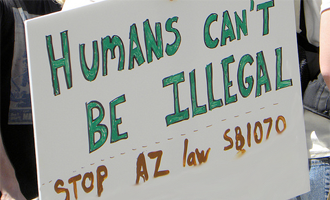
Originally published in June 2013.
Immigration – and public policies to manage it – arouses strong emotions and fierce social and political battles, not just in the United States but in most other countries across the world. Why is this true? Each nation has its own issues that inspire or enrage, of course, but there are widespread, underlying patterns that can be identified and taken into consideration by reformers.
Reformers trying to facilitate immigration are often locked in battles with groups that want to place limits on international migration. Combatants start from very different world views – not only emphasizing different values but almost speaking different languages. To avoid destructive backlashes, reformers must understand and respect the values and perspectives of all groups involved in public debates, as we can see from a closer look at the United States.
Immigration Advocates Often Stress Broad Economic Gains
Advocates for more open immigration policies tend to talk about economic benefits. The unspoken premise is holistic and utilitarian: when most of us are better off, then supposedly everyone gains. Social science research backs this idea. Immigration usually proves to be a net positive for host societies, providing workers and consumers who help boost economic growth, and tax revenues. Alan Greenspan, the former Chairman of the U.S. Federal Reserve Board, emphasized another benefit when he argued that immigrant labor lowers prices and thus helps keep inflation in check.Research further shows that immigrant workers, especially the low-skilled, normally complement rather than compete with host society workers. Today, not enough Americans are available to work in jobs at places such as fast food restaurants and summer resorts. Sociologist Frank Bean and his colleagues show that only about ten percent of working-age Americans currently have less than a high school education, compared to more than 80 percent in 1950. Low-skilled jobs are sadly still proliferating, but there are many fewer natives willing to claim them.
Although economic and demographic realities may support opening doors for immigration, such arguments mean little to voters who feel they are losing out. One poll found that more than 15 percent of Americans say they know someone who has lost a job to an immigrant, or say they have suffered such a loss. Such citizens wonder, “Why should I pay the cost of immigration? What about me?”
What Scholars Know about Anti-Immigrant Attitudes
Anti-immigrant sentiment is not just about economics, however. Social science research points to broader social concerns as well. The bad news is that native social fears about immigrants are common. The good news is that adverse attitudes are not inevitable or immutable.
When do fears about immigrants tend to peak? Scholars have learned that the type of newcomers entering a country matters – typically, there is much more native opposition to low-skilled migrants than to high-skilled newcomers such as physicians. This may be because low-skilled migrants are more likely to have large differences from native populations in lifestyle, language, or religion, and these can seem more threatening.

The social contexts in which natives and newcomers interact with one another matter a great deal, and in complex ways. Anti-immigrant views can spike in places with rapidly growing immigrant populations, especially in host communities that already faced adverse economic challenges. Many places in the American South and Midwest fit this description, and reformers seeking to ease immigration need to be especially sensitive in these contexts. Reformers inspired by ideas about universal human rights often push to extend protections to the most vulnerable – and soon find themselves in cultural clashes with host populations that see such people as threats.
Although low-skilled immigrants are at risk to face the most negative reactions, not all of them face the same level of risk. Low-skilled newcomers often face hostile reactions if they do not speak the host society language, if they cannot or do not hold jobs, or if they have arrived without legal authorization. Anti-immigrant restriction movements can flare in such situations.
Media coverage of immigrants can also make a difference, in sometimes surprising ways. A troubling research finding is that anti-immigrant views may go up following increased media coverage – whether it is positive or negative. Just making immigrants more visible can arouse tensions.
How to Bridge the Divides
The foregoing suggests at least three different perspectives through which differently situated social groups view immigration and immigrants. National experts and policymakers often take a utilitarian, economic view, while rights-oriented advocates stress universal human dignity and equal protections for migrant workers and residents. But the most consequential perspective, and one held by a large number of ordinary citizens, is what we can call the traditional community perspective. This is about valuing stable communities. For people invested in community life ways, changes brought by immigrants can be unwanted and threatening.
While racism should be condemned, reformers need to be careful not to label citizens who value established practices as “racists.” After all, traditional community ties are often a source of strength. For example, when journalist Scott Pelley asked residents in one long-established New York community repeatedly struck with disasters what got them through the rough times, they emphasized what one woman called the “three F’s: family, friends, and faith. Everybody cares about each other.” We hear the same stories from victims of fierce tornadoes in Oklahoma.
People viscerally understand how valuable stable community ties can be, and no one should be surprised that citizens who live in (or even just recall) stable communities are prone to see immigration as threatening – and can become easy marks for elites trying to politicize their fears. Reformers wishing to protect immigrant rights would do well to find ways to respect, and work with, traditional community values. The responsible path to reform honors established values, while extending opportunities and rights to newcomers.

 Research to Improve Policy: The Scholars Strategy Network seeks to improve public policy and strengthen democracy by organizing scholars working in America's colleges and universities. SSN's founding director is Theda Skocpol, Victor S. Thomas Professor of Government and Sociology at Harvard University.
Research to Improve Policy: The Scholars Strategy Network seeks to improve public policy and strengthen democracy by organizing scholars working in America's colleges and universities. SSN's founding director is Theda Skocpol, Victor S. Thomas Professor of Government and Sociology at Harvard University.
Comments 2
B — June 22, 2013
The desire for a stable community is important. Historically, immigrants have tried to assimilate into our American culture and thus quickly become a part of the existing `community’. People came to America because they wanted to become Americans.
Sadly, anti immigrant views have been fueled by the concept of ‘multiculturalism’, something inconsistent with the idea of assimilation. It is not reassuring to existing communities to be told that they should accept immigrants who believe that they have no obligation to learn the language, social customs and other cultural attributes of those communities. In effect, it seems many (who should know better) believe that immigrants should be entitled to the advantages of America without needing to become `American’. Thus, over the past few decades, educators and government policy makers, by embracing the notion of multiculturalism, are not helping to advance community acceptance of immigration.
Another major factor relates to the issue of fairness. To some, fairness relates primarily to the distribution of wealth and income. To others fairness relates more to the equal distribution of opportunity and `starting points’. The idea of giving those who have entered the U.S. illegally a head start over those who follow our immigration laws seems unfair to many people.
With regard to the preference for high skilled immigrants over lower skilled ones. I think most people understand that higher skilled immigrants are likely to contribute more to economic growth and tax revenues. Low skilled workers, who rely primarily on youthful physical abilities, are more likely to be a net consumer of government services over the period of a lifetime. So it’s probably not a matter of `hostility’ toward low skill immigrants but rather, simple economics and the realization that the future of the American economy and national security is more likely connected to our supply of high-skill, rather than low-skill individuals.
As for the ‘availability’ of native low-skilled native workers; that may have more to do with American cultural changes than with education (and perhaps the lower native birth rate? )My friends and I all graduated from college but during high school did some burger-flipping, car washing, etc. It was good training for the adult world and great motivation for attending college. Sadly, many of today’s young people, regardless of economic class, are being deprived of the valuable experience that their parents and grandparents gained from engaging in short periods of low-skill work.
Emma Decosta — October 31, 2013
Do you know EB1 is one of the groups in the first preference category of employment-based immigration, which benefits foreign nationals who have reached the top of their field of endeavor? Do you know approval rate of EB1 is 62% and EB1 petition filed immigration-center have almost 100% approval rate?
An alien of extraordinary ability is an alien who has extraordinary ability in the sciences, arts, education, business, or athletics which has been demonstrated by sustained national or international acclaim, whose achievements have been recognized in the field through extensive documentation.
Advantages of EB1-A classification are:
No labor certification is required
No job offer or permanent job position is required
Self-petition is allowed
All visas are current so it much faster to obtain a Green Card in this category than others
Immigration law is constantly changing. What was not able to be done one day, may be doable the next. Every case is unique, no matter how much someone else's situation sounds like yours, it is not. Our experienced immigration attorneys keep current on all the latest changes occurring in immigration law and offering preparation of immigration applications of all sorts.
You need to speak with our experienced immigration attorneys to learn your rights and what options you really have. You may have more options available than you realize.
Contact us now for a FREE CONSULTATION!
Center for Immigration Services
Email: info@immigration-centers.com
www.immigration-centers.com